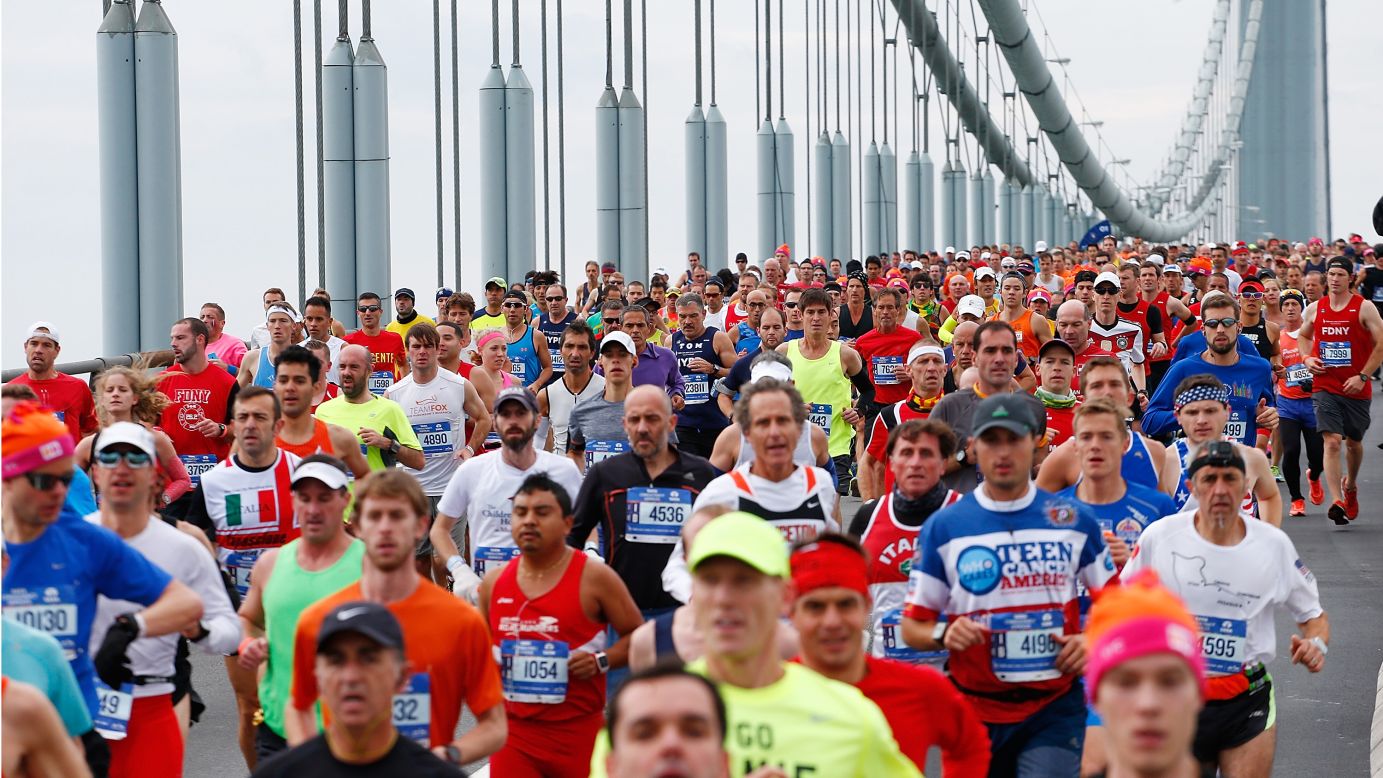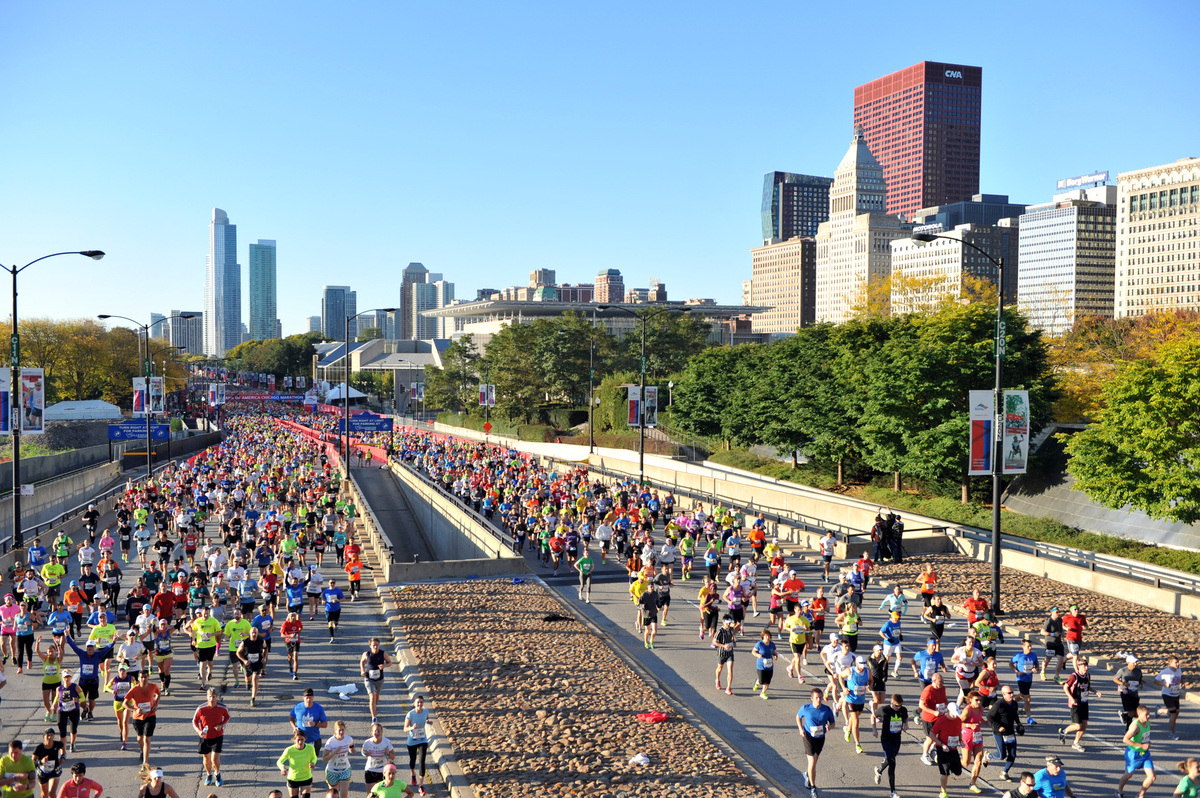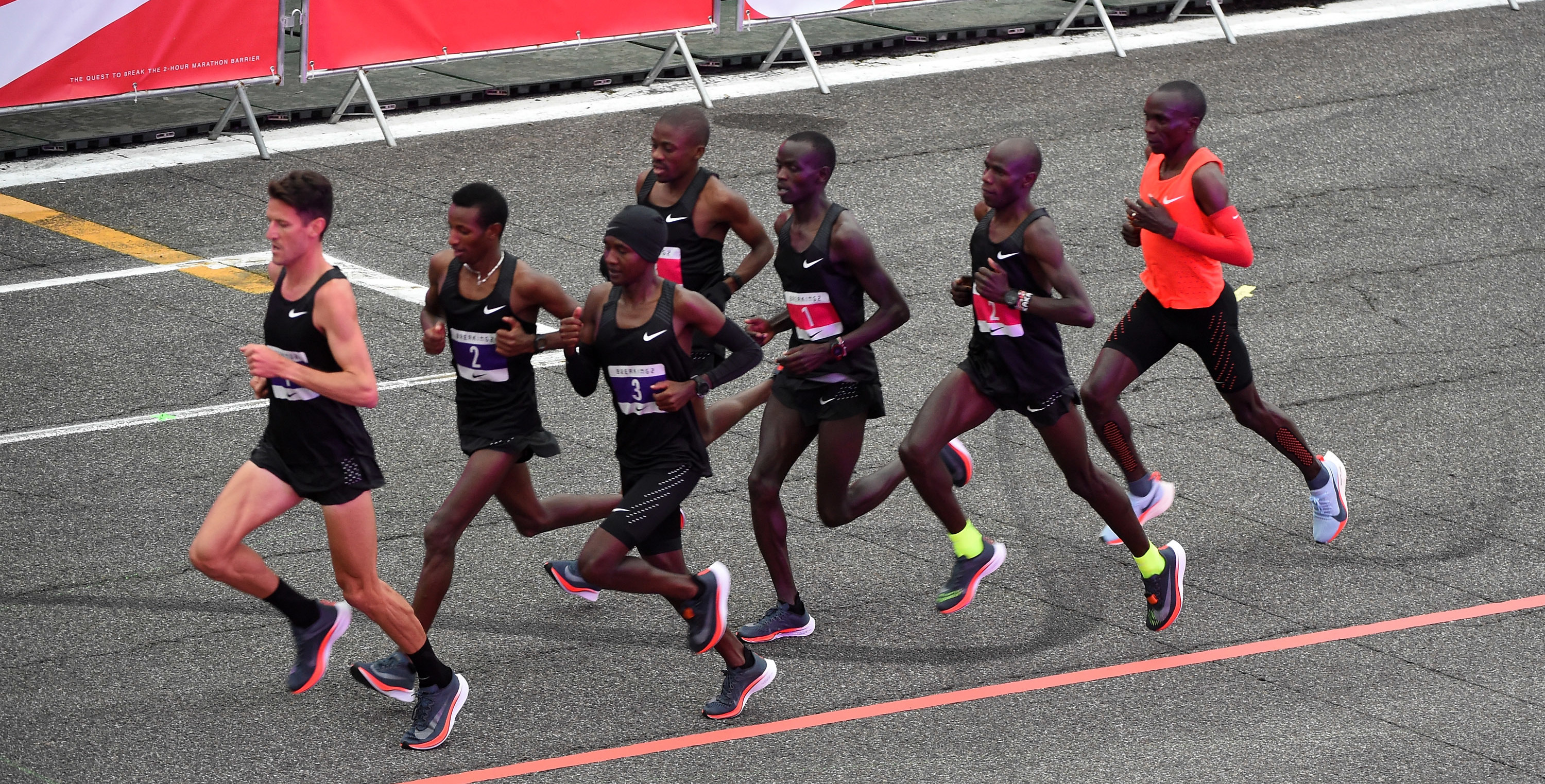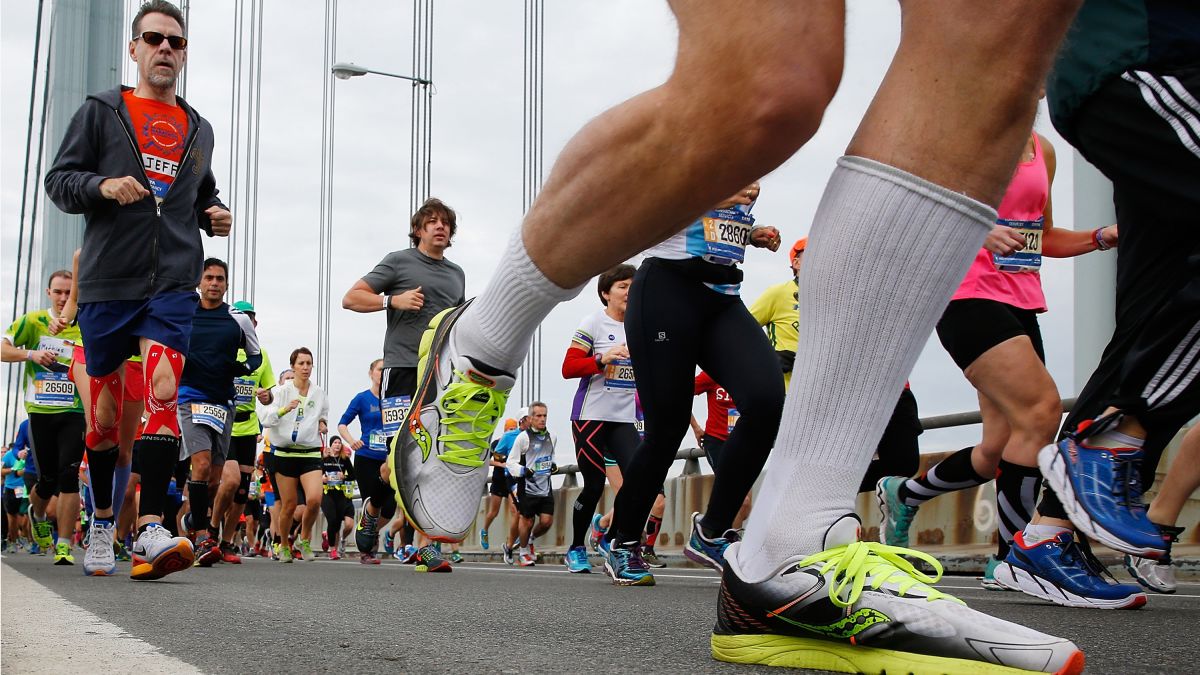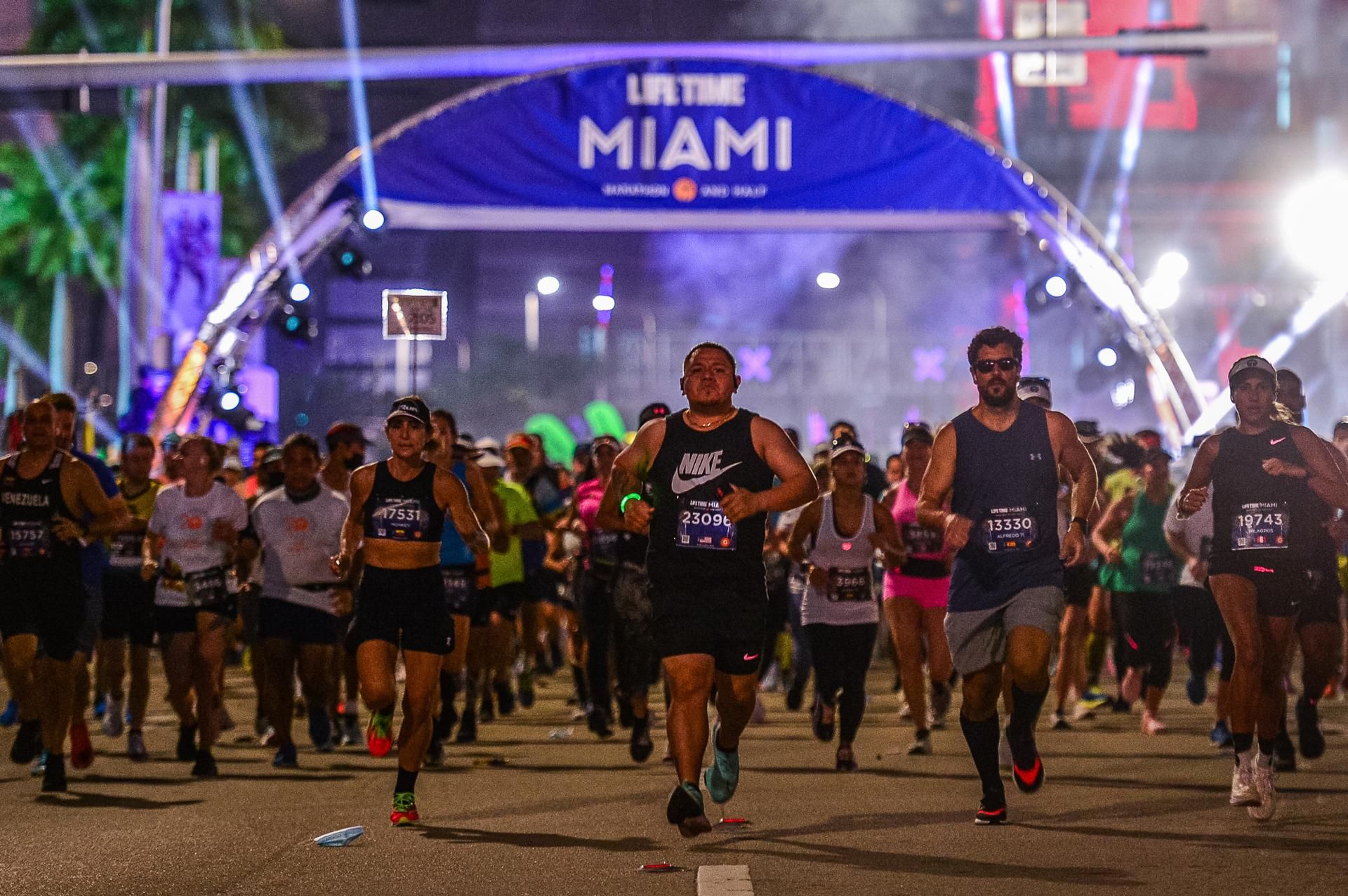

Featured
When Is The Miami Marathon
Modified: January 22, 2024
Get all the details about the featured Miami Marathon, including the date, location, and registration information. Don't miss out on this exhilarating event!
Introduction
The Miami Marathon is one of the most prestigious and exciting running events in the United States. Held annually in the vibrant city of Miami, Florida, the marathon attracts thousands of participants from all over the world. Whether you are an experienced marathoner or a first-time runner, the Miami Marathon offers a thrilling race experience with a scenic course, competitive fields, and a festive atmosphere.
With its stunning waterfront views, diverse cultural attractions, and tropical climate, Miami provides the perfect backdrop for an unforgettable marathon. This iconic event has a rich history, spanning several decades, and has become a staple in the running community.
Not only is the Miami Marathon a challenging race, but it is also an opportunity to soak up the vibrant energy of Miami. From the bustling streets of downtown to the picturesque beaches, runners will immerse themselves in the sights, sounds, and flavors of this dynamic city.
Whether you are aiming for a personal best time, seeking to complete your first marathon, or simply looking to enjoy the camaraderie of fellow runners, the Miami Marathon offers something for everyone. The excitement and support from the crowd, along with the scenic course, make for a truly memorable experience.
In this article, we will delve into the history of the Miami Marathon, explore the course and race categories, provide information on registration and fees, offer training tips, discuss the weather and conditions, highlight past winners, and provide useful information for spectators. So, lace up your running shoes and join us on this exciting journey through the Miami Marathon!
History of the Miami Marathon
The Miami Marathon has a rich history that dates back to its inaugural race in 2003. Founded by Frankie Ruiz, the marathon was originally known as the ING Miami Marathon and Half Marathon. Since then, it has grown in popularity and has evolved into one of the premier running events in Florida.
Over the years, the Miami Marathon has attracted runners from all over the world, creating a diverse and international atmosphere. The event has become known for its warm and welcoming vibe, reflecting the vibrant culture and spirit of Miami.
The marathon has seen many memorable moments and record-breaking performances. Elite runners from around the globe flock to Miami to test their limits on this fast and flat course. Notably, the Miami Marathon has been a qualifying race for prestigious events such as the Boston Marathon.
In 2014, the ING sponsorship ended, and the event was renamed the Fitbit Miami Marathon. This partnership allowed for further development and improvements to the race, ensuring a top-notch experience for participants.
Since its inception, the Miami Marathon has not only been a challenging race for seasoned runners but also a platform for supporting charitable causes. The marathon has partnered with numerous nonprofit organizations, raising funds and awareness for various social and community initiatives.
Throughout its history, the Miami Marathon has continually strived to provide an exceptional experience for participants. The event organizers have listened to participant feedback and made adjustments to enhance the course, improve logistics, and incorporate exciting race day festivities.
Today, the Miami Marathon continues to attract a large field of participants, ranging from elite athletes to casual runners. The combination of a scenic course, ideal weather conditions, and the vibrant energy of Miami makes this marathon an unforgettable experience for all who participate.
Course Description
The Miami Marathon showcases the stunning beauty of Miami as participants embark on a 26.2-mile journey through the city. The course is strategically designed to provide runners with a mix of urban landscapes, breathtaking waterfront views, and iconic landmarks.
The race begins in the downtown area, right in the heart of Miami. Runners will navigate through the bustling streets, feeling the energy and excitement of the city’s vibrant atmosphere. As they make their way out of downtown, they will pass by historic neighborhoods and iconic architectural landmarks.
As the course weaves through different areas of Miami, runners will be treated to panoramic views of the sparkling Biscayne Bay and the picturesque Miami Beach. The sight of the azure waters and the palm-lined beaches will serve as a reminder of the tropical paradise that is Miami.
The course also takes participants through some of the city’s most vibrant and culturally significant areas. Runners will pass by the colorful Art Deco buildings of South Beach, the stylish boutiques of the Design District, and the vibrant murals of the Wynwood Walls.
Despite the occasional inclines and bridges, the Miami Marathon course is generally flat and fast, making it an excellent choice for runners aiming for a personal best time. The flat terrain allows participants to maintain a steady pace throughout the race, while the breathtaking scenery provides a distraction from the physical challenge.
In addition to the main marathon course, the Miami Marathon also offers a half marathon option for those looking for a shorter distance. The half marathon course shares a significant portion of the marathon route, allowing participants to experience the best of Miami on a slightly condensed route.
Water and aid stations are strategically placed along the course to ensure that runners stay hydrated and receive any necessary medical attention. The Miami Marathon is well-organized, with ample signage and volunteers guiding participants along the route.
As runners approach the finish line in Bayfront Park, they are greeted by the cheers and support of spectators who have gathered to celebrate their accomplishments. The exhilarating finish is a testament to the determination and hard work put in by each participant.
The Miami Marathon course is not only a test of physical endurance but also a journey through Miami’s vibrant culture and breathtaking landscapes. Whether you’re chasing a personal record or simply soaking up the atmosphere, this course promises an unforgettable marathon experience.
Race Categories
The Miami Marathon offers a variety of race categories to accommodate participants of all levels and preferences. Whether you’re a seasoned marathoner, a first-time runner, or looking for a shorter distance challenge, there’s a race category for you.
The main event, of course, is the full marathon, covering a distance of 26.2 miles. This category is designed for experienced runners who are ready to tackle the challenge of a full marathon. Participants in this category will take on the entire course, experiencing the beauty and energy of Miami as they run through its vibrant streets.
For those who prefer a shorter distance, the Miami Marathon offers a half marathon category. Covering 13.1 miles, this race allows runners to still experience the excitement and scenery of the full marathon course, but in a slightly more manageable distance. The half marathon category is a popular choice for both novice and experienced runners.
In addition to the full marathon and half marathon categories, the Miami Marathon also offers a Corporate-Team category. This category allows businesses and organizations to form teams of runners to participate in the marathon. It fosters a sense of camaraderie and friendly competition among colleagues, while also promoting a healthy and active lifestyle.
For those who are not quite ready for the challenge of a full or half marathon, but still want to be a part of the Miami Marathon experience, there is a 5K option. This category covers a distance of 3.1 miles and is ideal for beginners, families, and casual runners. It provides an opportunity to join in the festivities and experience the energy of the Miami Marathon without the commitment of a longer race.
In addition to these main race categories, the Miami Marathon also offers separate divisions for wheelchair athletes. This inclusion allows athletes with disabilities to compete alongside able-bodied athletes, showcasing their determination and athletic abilities.
Regardless of the race category chosen, all participants of the Miami Marathon receive a race bib and timing chip to track their progress. Finishers are awarded a medal as a token of their accomplishment and can take pride in completing one of Miami’s most iconic running events.
The race categories of the Miami Marathon cater to a wide range of participants, ensuring that everyone can be a part of the excitement and achievement. Whether you’re aiming for a fast time, a personal best, or simply seeking to cross the finish line, the Miami Marathon has a race category that suits your goals and aspirations.
Registration and Fees
Registering for the Miami Marathon is a straightforward process that can be done online through the event’s official website. Here are the details regarding registration and fees:
Early registration is highly recommended as the Miami Marathon attracts a large number of participants and spots can fill up quickly. Early bird registration typically opens several months in advance, providing a discounted registration fee for those who sign up early.
The registration process involves filling out an online form with personal information, selecting your desired race category, and submitting the required payment. Payment is generally accepted via credit card, and the registration fee varies depending on the race category and the time of registration.
It is important to note that the Miami Marathon operates on a tiered pricing system, where the registration fees gradually increase as the event date approaches. Early bird registration offers the lowest fees, while last-minute registration carries a higher cost. It is advisable to register as early as possible to secure the best price.
In addition to the standard registration fee, participants may also have the option to purchase additional add-ons, such as event merchandise or race day amenities. These add-ons can be selected during the registration process and are subject to an additional cost.
It is crucial to carefully read and understand the registration terms and conditions, as they often outline important information regarding refunds, deferrals, and transfer policies. Many events have strict policies regarding these matters, so it is important to be aware of the terms before completing the registration process.
Once registration is successfully completed and payment is processed, participants will receive a confirmation email with their race details and any additional instructions. It is essential to keep this confirmation email for reference and as proof of registration during race weekend.
For participants traveling from out of town, it is advisable to book accommodation well in advance, as the Miami Marathon attracts a large number of visitors. Many hotels in the area offer special rates and packages for marathon participants, so it is worth exploring these options.
While the Miami Marathon does not typically offer race day registration, it is always best to check the event’s official website for the most up-to-date information regarding registration availability, fees, and any special promotions or discounts that may be offered.
Registering for the Miami Marathon is the first step towards an incredible experience of challenging yourself and being part of Miami’s vibrant running community. So don’t wait, secure your spot and start your training for this exciting marathon!
Training Tips
Preparing for the Miami Marathon requires a well-planned and consistent training regimen. Whether you’re a seasoned marathoner or a first-time participant, here are some training tips to help you maximize your potential and cross the finish line strong:
1. Develop a Training Plan: Create a structured training plan that includes a balance of endurance runs, speed workouts, and recovery days. Gradually increase your mileage each week to build your stamina and endurance.
2. Consistency is Key: Stick to your training plan and be consistent with your workouts. Regular training will help you build a solid foundation of fitness and prepare your body for the demands of marathon day.
3. Include Cross-training: Incorporate cross-training activities like cycling, swimming, or strength training to improve overall fitness, prevent injuries, and enhance your performance.
4. Long Runs: Schedule long runs once a week to build your endurance. Gradually increase the distance of your long runs, simulating the demands of the marathon distance.
5. Practice Speed Workouts: Incorporate interval training, tempo runs, and hill repeats to improve your speed, strength, and running efficiency. These workouts will help you maintain a faster pace during the race.
6. Listen to Your Body: Pay attention to any signs of fatigue, pain, or injuries. It’s important to strike a balance between pushing yourself and allowing for adequate rest and recovery. Take rest days when needed and seek medical attention if necessary.
7. Nutrition and Hydration: Fuel your body with a well-balanced diet that includes carbohydrates, proteins, and healthy fats. Stay hydrated throughout your training and experiment with different fueling strategies during long runs to find what works best for you.
8. Mental Training: Runners often underestimate the importance of mental preparation. Practice visualization techniques, positive self-talk, and mental toughness exercises to develop strong mental resilience and overcome challenges during the race.
9. Gradual Taper: Prior to race day, reduce your mileage and intensity gradually to allow your body to recover and peak on race day. This tapering period will help you feel fresh and energized for the marathon.
10. Race-Day Strategy: Plan your race-day strategy including pacing, nutrition, and hydration. Familiarize yourself with the course and visualize your success. Stay positive and embrace the emotions of the race day experience.
Remember, everyone’s training journey is unique. It’s important to find what works best for you and listen to your body. Stay committed, trust your training, and enjoy the process. With proper preparation and training, you’ll be ready to conquer the Miami Marathon and celebrate your accomplishment. Good luck!
Weather and Conditions
The Miami Marathon is held in a city known for its beautiful weather and year-round sunshine. However, it’s important to understand and prepare for the weather and conditions you may encounter during the race. Here is some information to help you plan accordingly:
The Miami Marathon takes place in January, which is typically a pleasant time of the year in Miami. The average temperatures range from the mid-60s to low 70s Fahrenheit (around 18 to 23 degrees Celsius). The mornings are often cooler, while the temperatures rise as the day progresses.
While the temperatures may be relatively mild, humidity can be a factor to consider. Miami is known for its high humidity levels, especially during the early morning hours. It’s essential to stay adequately hydrated throughout the race and consider wearing lightweight, breathable clothing to help manage sweat and moisture.
Participants should also be aware of the potential for rain during the marathon. January is part of Miami’s dry season, but sporadic rain showers are still possible. It’s a good idea to pack a lightweight rain jacket or a poncho, just in case you encounter precipitation during the race.
The Miami Marathon course is mostly flat, with a few elevated points such as bridges to navigate. The terrain is generally well-maintained and smooth, allowing for a comfortable running experience. However, it’s still advisable to be cautious of any potential hazards along the course and remain aware of your surroundings.
Due to the waterfront nature of the course, participants may also experience some wind along certain sections, especially near the bay or Miami Beach. It’s important to factor in potential wind resistance and adjust your pace and effort accordingly to maintain a steady and efficient running form.
It is recommended to check the weather forecast leading up to the race and stay informed about any updates or changes. The event organizers will also provide participants with regular updates regarding any weather-related modifications or precautions.
Regardless of the weather conditions, staying prepared and adaptable is key. Dress in layers that you can easily remove if needed, and consider wearing moisture-wicking fabrics to help regulate your body temperature. Apply sunscreen to protect your skin from the sun’s rays, even on overcast days.
Lastly, listen to your body and adjust your race strategy accordingly. If the temperatures are higher or the conditions more challenging than anticipated, it may be necessary to slow your pace and focus on conserving energy and staying hydrated throughout the race.
By staying mindful of the weather and conditions, and taking steps to adapt and prepare accordingly, you can optimize your performance and maximize your enjoyment of the Miami Marathon.
Past Winners
Over the years, the Miami Marathon has witnessed remarkable performances from elite athletes who have made their mark in the history of the race. Here are some notable past winners who have triumphed in this prestigious event:
In the men’s category, one name that stands out is Luis Carlos Riveros from Colombia. Riveros won the Miami Marathon multiple times, showcasing his exceptional speed and endurance. His victories have solidified his status as one of the greats in marathon running.
In the women’s category, Esther Atkins from the United States has left a lasting impact on the Miami Marathon. With her strong performances and impressive times, Atkins has emerged as a dominant force in the race. Her determination and perseverance have earned her the respect of fellow runners.
Other notable winners in the Miami Marathon include Nadezhda Leonteva from Russia and Yemane Adhane Tsegay from Ethiopia. Leonteva ran a spectacular race, demonstrating her strength and skill. Tsegay, known for his impressive career in long-distance running, showcased his exceptional talent during his victory in the Miami Marathon.
It’s also worth mentioning the incredible performances of local runners who have made their mark on the Miami Marathon. These individuals, hailing from the Miami area, have demonstrated their talent and dedication on their home turf, inspiring others in the local running community.
While these exceptional athletes have claimed victory in the Miami Marathon, it is important to remember that every participant who crosses the finish line is a winner in their own right. The Miami Marathon celebrates the personal achievements and milestones of each and every participant.
With a rich history of outstanding performances and incredible moments, the Miami Marathon continues to attract top-tier talent from around the world. As the race evolves and new runners emerge, we can look forward to witnessing future champions leave their mark on this prestigious event.
Whether you’re an elite athlete vying for the top spot or a recreational runner chasing personal goals, the Miami Marathon offers an opportunity to be part of the legacy and join the ranks of the past winners who have etched their names into the race’s history.
Expo and Packet Pickup
The Miami Marathon Expo and Packet Pickup is an exciting event held in conjunction with the marathon. It serves as an important milestone in the lead-up to race day, providing participants with the opportunity to collect their race packets, browse through exhibitor booths, and immerse themselves in the energetic atmosphere of the event.
The Expo typically takes place over a couple of days leading up to the marathon, offering participants flexibility and convenience in picking up their race essentials. It provides a one-stop-shop for all things related to the Miami Marathon, including bibs, timing chips, race maps, and event merchandise.
At the Expo, participants have the chance to explore a variety of exhibitor booths showcasing the latest in running gear, equipment, and nutrition. Many well-known brands and local vendors participate in the Expo, providing an excellent opportunity for participants to discover new products, seek advice from experts, and stock up on race-day necessities.
In addition to shopping and picking up race essentials, the Expo also hosts educational seminars, guest speakers, and interactive sessions that cater to all aspects of running and marathon preparation. These sessions cover a wide range of topics such as training tips, injury prevention, nutrition strategies, and race day strategies.
The Expo is not only a practical event but also a social gathering for participants, spectators, and running enthusiasts. It fosters a sense of community and camaraderie among individuals who share a common passion for running. This environment allows participants to connect with fellow runners, share stories, and gain motivation before taking on the marathon.
It is important for participants to check the event’s official website for the exact dates, location, and opening hours of the Expo and Packet Pickup. Many organizers also offer the option for participants to have someone else collect their packets on their behalf, provided they have the necessary authorization.
As an integral part of the Miami Marathon experience, the Expo and Packet Pickup is an event not to be missed. It offers participants the convenience of collecting their race materials, the opportunity to discover new products and resources, and the chance to immerse themselves in the vibrant running community. It’s a celebration of all the hard work and preparation that has led up to the marathon and serves as a memorable prelude to the main event.
Spectator Information
The Miami Marathon is not just an exciting event for participants but also offers a fantastic experience for spectators. If you’re planning to cheer on your friends, family, or other runners, here’s some essential information to help you make the most of your spectator experience:
Course Information: Familiarize yourself with the race course and plan your viewing spots in advance. The Miami Marathon provides a map of the race course, which can be found on the event’s official website. Choose locations that offer good visibility and access to amenities such as restrooms and food vendors.
Arrive Early: Plan to arrive at your chosen viewing spot well in advance of when you expect the runners to pass by. This will give you ample time to find parking, secure a good viewing position, and soak up the pre-race atmosphere.
Bring Signs and Cheer: Get creative and make signs to show your support for the runners. Encouraging and motivational signs can make a huge difference to the runners’ morale during the race. Bring noise-makers, bells, and clappers to create a fun and lively atmosphere. Your energy and cheers will undoubtedly boost the spirits of the participants.
Track Runners: Utilize the tracking tools provided by the Miami Marathon organizers to keep up with your favorite runners. Many races offer live tracking options through their official websites or mobile apps. This will allow you to pinpoint their location along the course and ensure you don’t miss them as they pass by.
Stay Hydrated and Sunscreen: As a spectator, it’s essential to take care of yourself as well. Stay hydrated by bringing water or other hydrating beverages, especially if you plan to spend a significant amount of time along the race course. Apply sunscreen to protect yourself from the sun’s rays, as you may be exposed to the elements for an extended period of time.
Cheer for All: While cheering for your friends or family members is a priority, don’t forget to cheer for all the runners. A marathon is a challenging endeavor, and every participant appreciates the support from spectators. Shout words of encouragement, clap, and cheer for all the runners as they pass by. Your positive energy will make a difference in their race experience.
Capture the Moment: Bring your camera or smartphone to capture memorable moments along the race course. Cheer, snap photos, and take videos of the runners in action. Your photographs and videos will be cherished by the runners and serve as a lasting memory of their accomplishment.
Respect Course Etiquette: While it’s exciting to be a spectator, it’s important to respect the race course and follow any guidelines provided by event organizers. Avoid interfering with the runners and follow instructions from race officials and volunteers. Remember, safety and fairness are of utmost importance to ensure a successful and enjoyable event for all.
Spectating at the Miami Marathon is an incredible experience that allows you to witness firsthand the determination and resilience of the runners. By offering your encouragement and support, you become an integral part of their journey towards the finish line. So, come prepared, bring your enthusiasm, and make some noise as you cheer on the participants of the Miami Marathon!
Frequently Asked Questions (FAQs)
As the Miami Marathon approaches, participants and spectators may have questions about various aspects of the event. Here are some commonly asked questions along with their answers to help you navigate the Miami Marathon:
1. What is the minimum age requirement to participate in the Miami Marathon?
The minimum age requirement for the full marathon and half marathon is 18 years old. However, the 5K race has no age restrictions, making it suitable for participants of all ages.
2. Can I transfer my registration or defer it to next year?
The Miami Marathon does not allow for registration transfers or deferrals. All registrations are non-transferable and non-refundable, as stated in the event’s registration policy. It is important to review the terms and conditions before registering for the race.
3. Is there a time limit to complete the marathon?
Yes, there is a time limit imposed for the marathon. Typically, participants must finish the course within 6 hours and 30 minutes from the start time. This allows for an average pace of around 15 minutes per mile. It’s important to train and pace yourself accordingly to ensure you finish within the allotted time.
4. Can I walk instead of run the marathon?
Yes, walking the marathon is allowed. The Miami Marathon welcomes participants of all abilities, including walkers. However, it’s important to keep in mind the time limit to complete the race, as mentioned in the previous question. Plan your pace accordingly to ensure you finish within the designated time frame.
5. Are strollers or pets allowed on the course?
For safety reasons, strollers and pets are not permitted on the race course. This rule ensures the safety and well-being of all participants and spectators. Exceptions may be made for individuals with disabilities who require assistance, but it’s best to contact the event organizers in advance to make arrangements.
6. Is there a bag check available on race day?
Yes, the Miami Marathon provides a bag check area for participants to store their belongings during the race. Participants receive a clear bag at the Expo to use for bag check. It’s important to follow the bag check guidelines provided by event organizers to ensure a smooth process on race day.
7. Can I wear headphones during the race?
While the use of headphones is generally allowed, it is highly recommended to run without them for safety reasons. Being aware of your surroundings and being able to hear instructions from race officials is important. If you choose to wear headphones, keep the volume at a level that allows you to remain aware of your surroundings.
8. Are there designated cheering zones for spectators?
There are no specific designated cheering zones along the race course. Spectators are encouraged to choose their viewing spots along the course, keeping in mind accessibility, visibility, and amenities. It’s best to arrive early and secure a good spot to cheer on the runners.
9. Is there a Lost and Found at the race?
The Miami Marathon typically has a Lost and Found area where participants can inquire about lost items. If you lose or find any belongings during the event, seek assistance from race officials or volunteers to ensure that your items are properly managed.
10. Where can I find additional information about the Miami Marathon?
For more information about the Miami Marathon, including race details, registration, course maps, and event updates, it is best to visit the official event website. The website will provide the most up-to-date and accurate information regarding the event.
These FAQs aim to address some of the common questions participants and spectators may have about the Miami Marathon. If you have any specific inquiries or need further clarification, it is advisable to reach out to the event organizers directly for personalized assistance.
Conclusion
The Miami Marathon is an iconic and thrilling event that brings together runners from all walks of life. Whether you’re a seasoned marathoner aiming for a personal best time, a first-time participant looking to conquer a new challenge, or a spectator cheering on friends and family, the Miami Marathon offers an unforgettable experience.
From its rich history and scenic course to its diverse race categories and enthusiastic spectators, the Miami Marathon embodies the vibrant spirit of Miami. The event showcases the city’s stunning landscapes, cultural attractions, and energetic atmosphere, making it a unique and memorable marathon experience.
Preparation and training are key to making the most of this event. Participants should develop a training plan, stay consistent, and listen to their bodies throughout their marathon journey. Spectators should plan their viewing locations, bring their energy and encouragement, and enjoy being part of the vibrant cheering crowd.
The Miami Marathon is not just about the elite runners who cross the finish line first; it’s about celebrating the personal achievements and triumphs of each participant. Every step taken during the marathon represents dedication, determination, and the pursuit of personal goals.
As the sun rises over Miami on race day, participants will embark on a challenging and exhilarating journey through the city’s streets. Cheered on by enthusiastic supporters, they will push their limits and reach new heights of accomplishment.
Whether you’re running along the picturesque course or standing on the sidelines cheering, the Miami Marathon is an event that captures the essence of Miami’s energy, diversity, and resilience. It is a celebration of community, dedication, and the human spirit.
So, lace up your running shoes, gather your enthusiasm, and mark your calendars for the next Miami Marathon. Whether you’re a participant or a spectator, this event promises to be an experience you won’t want to miss. Embrace the challenge, soak in the beauty of Miami, and create memories that will last a lifetime.

